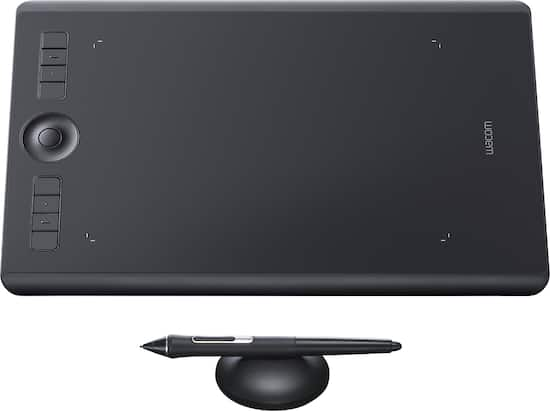Wacom Intuos Pro 2017 Review
When the Intuos Pro graphics tablet was announced at CES 2017, it sounded a little ho-hum. The reality is way better.
For the uninitiated, Wacom's Intuos (and Bamboo) tablets connect as input devices to your computer, adding pressure-sensitive drawing and painting as well as serving as a touchpad. Like its sister MobileStudio Pro product line of Windows tablets, one highlight of the 2017 Intuos Pro, which uses the same Pro Pen 2, is that it supports 8,192 levels of pressure and 60 degrees of tilt recognition, the most to date. (The actual resolution hasn't changed, though, remaining at 5,080 lines per inch/100 lines per millimeter.)
The other cool update is a new Paper edition, which includes an EMR-supporting finepoint gel pen. With it, you can draw on any paper while disconnected -- it stores up to 200 drawings in the tablet's built-in memory -- and then connect to sync your drawings to its cloud service using the company's Inkspace app. The strokes are captured in Wacom's Ink Layer Language (WILL), which allows for text recognition and exporting as a vector format from Inkspace.
Pricing
| Intuos Pro (medium) | Intuos Pro (large) | Intuos Pro Paper Edition (medium) | Intuos Pro Paper Edition (large) | |
| US | $350 | $500 | $400 | $550 |
| UK | £330 | £450 | £380 | £500 |
| Australia | AU$500 | AU$550 | AU$550 | AU$770 |
You can also turn the Intuos Pro into the Paper edition after the fact by purchasing the add-on kit with the pen and clip (though you can DIY your own clip). And the older Intuos Pro Pen & Touch model is still around if you want a small, as the latest version doesn't come in that size.
Wacom redesigned the tablet to occupy less space but retain the same active area, plus it added a power button and dedicated touch on/off switch, and the new stand is more elegant looking. It still stores the extra nibs, but has a new, clever system for replacing them. You can also buy Texture Sheets to obtain a smoother or rougher feel.
It connects via USB-C or built-in Bluetooth, and you pair it by holding down the center button for 6 seconds or so. A blinking blue light appears on the right side to indicate that it's in pairing mode.
Otherwise, it's pretty much the same as before, with a set of eight ExpressKeys and a Touch Ring, which can perform one of four functions based on the toggle status of the center button, and there's an onscreen menu with another eight functions. Everything's programmable on both global and individual application levels.
Putting pen to paper
For people who prefer starting out with sketches on paper, the Paper Edition is really cool. You attach a stack of up to 10 sheets of paper to the tablet with the bundled clip -- while you can stick any size paper on it, it only works on the center portion -- and when it senses the gel pen in proximity it goes into recording mode. A big blue cross appears on the toggle button when there's content waiting to be synced, and you initiate syncing by pressing it. When the buffer's clear, it turns green. Double tapping the button creates a new layer.
The primary benefit of the company's electromagnetic resonance (EMR) technology is that it doesn't require a battery to power the pen; that's doubly important with an ink pen. After all, who wants to have to replace the batteries in it? But that means you can't use any old ink replacement in it. It comes with three ink refills and a 10 pack of A5/letter or A4/half-letter size sheets (depending upon your tablet size) in addition to the 10 nibs for the Pro Pen. Additional refills come in a five-pack for $10 (£14; I can't find them on the Australian site, but the US price directly converts to AU$13).

Comments
Post a Comment